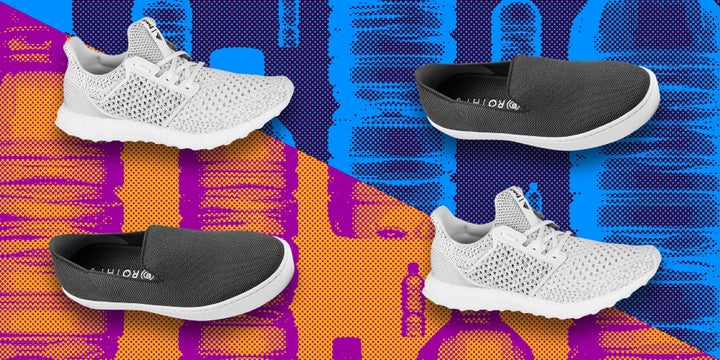
Recycled plastic has become the material du jour for the fashion industry.
But one area in which plastic has really taken off is footwear. Brands like Adidas, Rothy’s and Veja are just a few that are incorporating materials made of recycled plastic in their shoes. Plastic isn’t great for the environment: It’s harmful to wildlife and coral reefs, and there’s a good chance we humans are consuming plenty of it ourselves.
By repurposing plastic waste, brands aim to give it life beyond the landfill and prevent it from causing more harm than is already done, all while putting their products in a positive light.
Turning plastic bottles into sneakers isn’t a one-step process. To find out exactly how it’s done, we asked experts for some insight.
Where does the plastic come from, and how does it become shoes?
There are a number of steps involved in the process of turning plastic ― bottles or otherwise ― into the fibers used to create knit shoes, like the ones made by Rothy’s or Adidas x Parley.
First, the plastic needs to be collected. (There’s more than 6 billion metric tons of plastic waste in the world, according to a 2017 article published by National Geographic, so brands using it as their raw material have a generous supply.) Veja, a French footwear brand with a focus on company transparency, uses plastic collected from the streets of Rio de Janeiro and Sao Paulo to create the B-Mesh fabric used on some of its shoes. Rothy’s, an American footwear brand, gets recycled plastic from a U.S. supplier that sources it from all over. That plastic is then turned into the brand’s proprietary yarn, used for the uppers of all its shoes. Parley, which has partnered with Adidas since 2015, uses ocean plastic ― collected from beaches and coastal communities before it reaches the ocean ― to replace virgin plastic in the production of Adidas x Parley sneakers.
Once the plastic has been gathered, the process of turning it into long strands of yarn can begin. As Erin Lowenberg, creative director at Rothy’s, explained, plastic is heated into chips, then reduced to form small pellets, which are then extruded through machines to become “really long, easy fibers that become soft but also very durable,” she said, comparing it to dental floss.
Veja’s manufacturing process (you can see a glimpse of it in the video below) is similar: The plastic is collected, sorted and then turned into plastic flakes, which then become polyester fiber through an extrusion process, the brand’s co-founder, François Ghislain Morillion, told HuffPost via email.
How much plastic is actually used to make a shoe?
With so much waste in the world, how much of a dent do companies using recycled plastic actually make?
According to Adidas, every pair of shoes made with the Parley Ocean Plastic prevents 11 bottles from making their way into the oceans. The sportswear brand sold 1 million pairs of Parley shoes in 2017, an Adidas representative confirmed to HuffPost via email. According to its website, that means it retrieved at least 11 million bottles from coastal areas. The rep also told HuffPost that the brand aims to sell 5 million pairs of its Parley shoes in 2018 and 11 million pairs in 2019.
Lowenberg said Rothy’s has already used almost 20 million bottles in the production of its shoes, which is impressive considering the brand has only been selling them for about two years. Looking at things on a smaller scale, Morillion said each pair of Veja sneakers made with B-Mesh uses three water bottles on average.
Is recycled plastic a good long-term solution?
Using plastic waste to create new, useful products might seem like a great solution right now, but some have questioned whether the immediate benefits will have a lasting positive effect.
Plastic is plastic. As Morillion said, “Using recycled polyester lessens our dependence on petroleum as a source of raw materials but is not a biodegradable material, like organic cotton or leather.”
Even if plastic is being repurposed into new things like sneakers, there’s always a chance it will end up back in landfills, once again creating waste. (Then there’s the issue of microplastics ― small plastic pieces that are less than 5 millimeters long ― which are also said to be harmful to our oceans and wildlife.)
Céline Semaan, founder of Slow Factory, an innovation lab focused on sustainable practices, and a member of the board of directors of AIGA NY, told HuffPost that, in the short term, collecting plastic and turning it into knits and fabrics, like the varieties used in footwear, appears to be helpful. But in the long term, she argued, it might not be.
“If we are going to look at it like the Earth is going to end next week, yes, it’s a great idea. But if we are looking at it in terms of longevity and what happens next, that’s when it’s problematic,” she said. “It is helpful to remove the bottles and the plastic from the ocean that was not supposed to be there in the first place. These efforts are and should be rewarded.”
The problem, she suggested, is when the cycle ends with the production of a new product that comes with no intention of repurposing it multiple times.
“It is problematic,” Semaan said. “[Plastic] itself is a toxic material. Whatever we do with it is going to be problematic unless we think about it in a way that it’s going to be circular, to be reused again and again and not end up in landfills.”
One of the most innovative things a company can do, Semaan suggested, is take responsibility for the materials and products it puts out into the world and ask consumers to return them so they can be recycled or disposed of responsibly.
According to Lowenberg, Rothy’s is working toward that. Thinking about long-term solutions, she said, is part of the brand’s business model, though she acknowledged that the global issue of plastic waste won’t be solved by a single company. For their part, though, Rothy’s shoes are completely recyclable, and customers can return them through the brand’s partnership with PLUSfoam to make sure they’re disposed of properly.
Adidas has a “Take Back” program in place as well, allowing customers to return their used Adidas shoes at participating locations so they can be properly recycled and potentially reused. (It should be noted that the “Take Back” program isn’t currently an option in every Adidas store.)
Though Veja doesn’t currently have a recycling program in place ― its shoes are made of different materials, which have different recycling processes ―Morillion said the brand is “actively looking for solutions to devise a ‘cradle to cradle’ solution to reach 100 percent recycling.”
“For us, recycled plastics are just a part of the solution,” he said.
When talking about plastic and its effect on our planet, debates will always arise. Solutions to large-scale problems are seldom perfect. Repurposing recycled plastic is no exception. But it’s a start.
This story is part of a series on plastic waste, funded by SC Johnson. All content is editorially independent, with no influence or input from the company.

